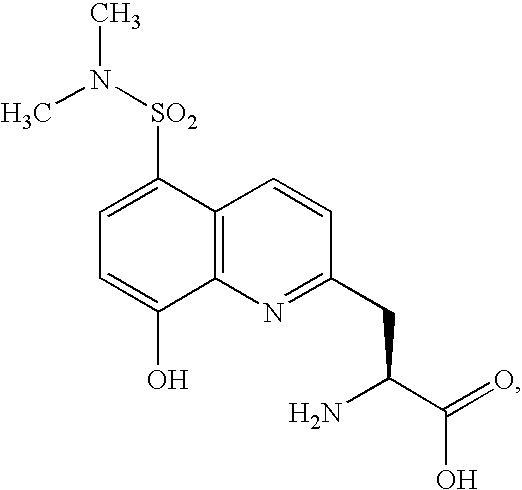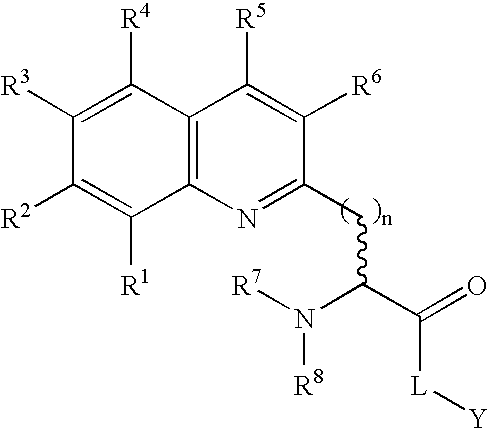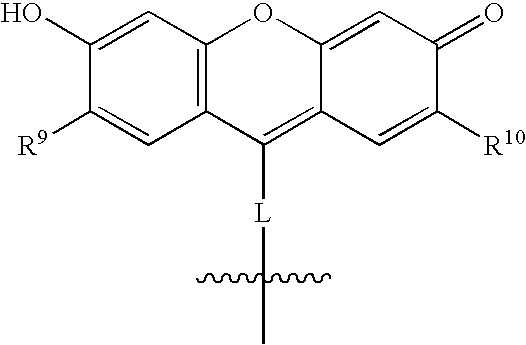Fluorogenic protein kinase substrates
a technology of fluorogenic protein and substrate, which is applied in the field of kinase sensors, can solve the problems of affecting the accuracy of fluorescent measurement, affecting the detection accuracy of fluorescent measurements, and posing disposal problems,
- Summary
- Abstract
- Description
- Claims
- Application Information
AI Technical Summary
Benefits of technology
Problems solved by technology
Method used
Image
Examples
example 1
Preparation of a Fluorescent Amino Acid Chelator
[0198]
[0199]To a solution of 8-hydroxyquinoline-5-carbaldehyde (A, Oakwood Products) in ethylene glycol, p-TsOH is added to form 5-(1,3-dioxolan-2-yl)quinolin-8-ol (B). After purification, 5-(1,3-dioxolan-2-yl)quinolin-8-ol is added to a solution of MeI and NaH in THF to give C. A solution of C in THF is added to 1 eq of the Grignard reagent formed from magnesium turnings and L-N-Boc-2-bromomethyl glycine allyl ester (Advanced Technology & Industrial Co., Ltd., Hong Kong) at 0° C.; the reaction mixture is monitored by TLC until allyl(S)-vinyl 2-(tert-butoxycarbonylamino)-3-(5-formyl-8-methoxyquinolin-2-yl)propanoate (D) is formed. The reaction mixture is quenched with aqueous acetic acid, and purified by flash chromatography. The O-methyl and N-t-BOC protecting groups are simultaneously removed by treatment of D with warm 48% HBr / HOAc. The freed aliphatic amino group is protected as a fluorenoxymethylenecarbonyl carbamate, followed by ...
example 2
Preparation of a Fluorescent Amino Acid Chelator
[0200]
[0201]As in Example 1, 8-methoxyquinoline was converted into its protected 2-aminoacid derivative A. Ring bromination installs a bromine substitutent at the 8-position (to give B), which is converted into its corresponding Grignard reagent by reaction with magnesium turnings in dry THF. Quench with trimethylborate affords the phenyl boronate C. Treatment with boron tribromide in dichloromethane removes the phenolic methoxy group and any remaining boronate methyl esters, affording arylboronic acid D. Palladium(0)-catalyzed Suzuki coupling of D with the known 3-bromo-4-methyl-7-diethylaminocoumarin E in the presence of sodium bicarbonate, followed by palladium(0)-mediated de-allylation (as in Example 1) affords compound F.
example 3
Preparation of a Fluorescent Magnesium Chelator
[0202]
[0203]Nitrosation of L-N-FMOC-meta-hydroxytyrosine methyl ester with isoamyl nitrite affords the key nitroso intermediate A. Saponification of A affords N-protected amino acid B, which is condensed with 1,3,5-trihydroxybenzene in sulfuric acid to give amino acid C.
PUM
| Property | Measurement | Unit |
|---|---|---|
| wavelengths | aaaaa | aaaaa |
| emission wavelength | aaaaa | aaaaa |
| emission wavelength | aaaaa | aaaaa |
Abstract
Description
Claims
Application Information
 Login to View More
Login to View More - R&D
- Intellectual Property
- Life Sciences
- Materials
- Tech Scout
- Unparalleled Data Quality
- Higher Quality Content
- 60% Fewer Hallucinations
Browse by: Latest US Patents, China's latest patents, Technical Efficacy Thesaurus, Application Domain, Technology Topic, Popular Technical Reports.
© 2025 PatSnap. All rights reserved.Legal|Privacy policy|Modern Slavery Act Transparency Statement|Sitemap|About US| Contact US: help@patsnap.com



